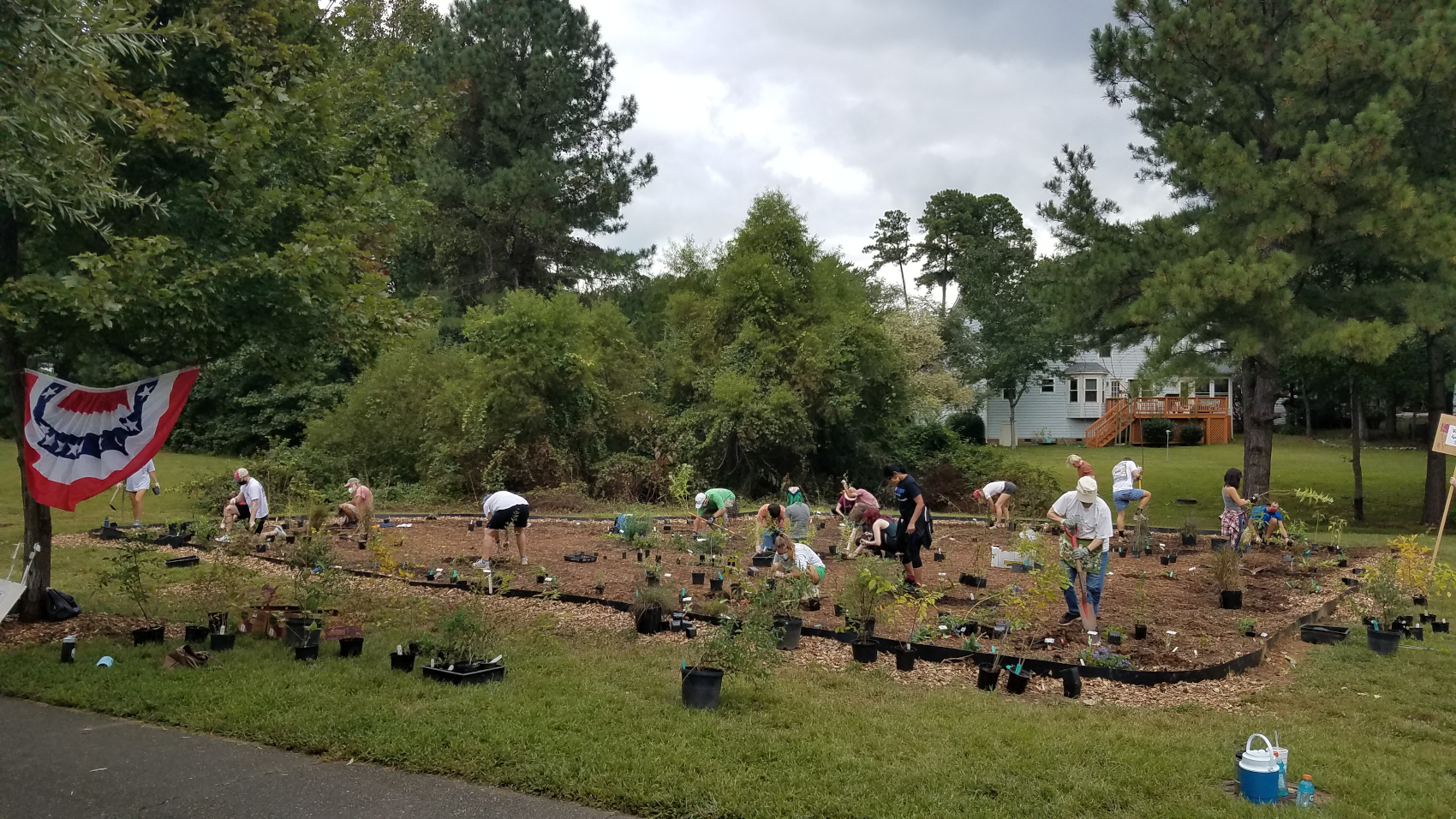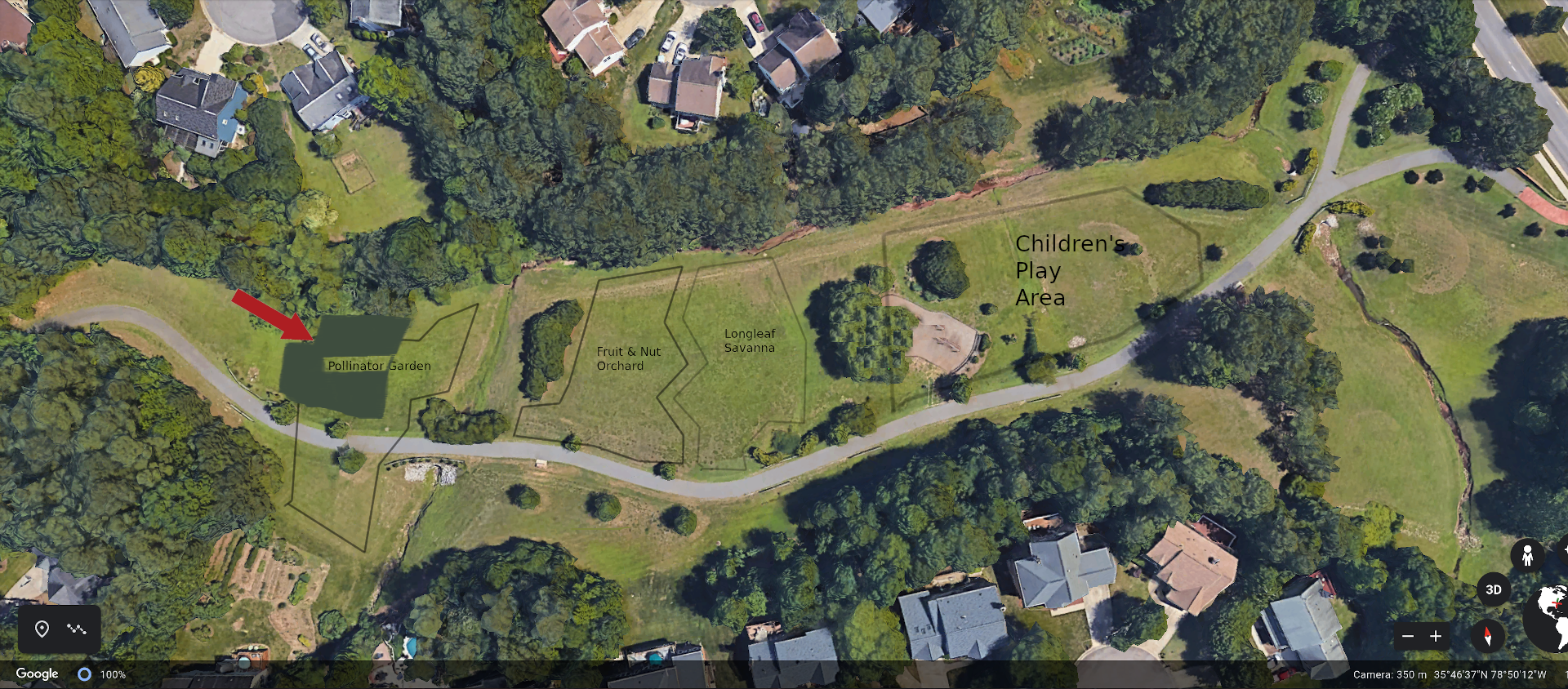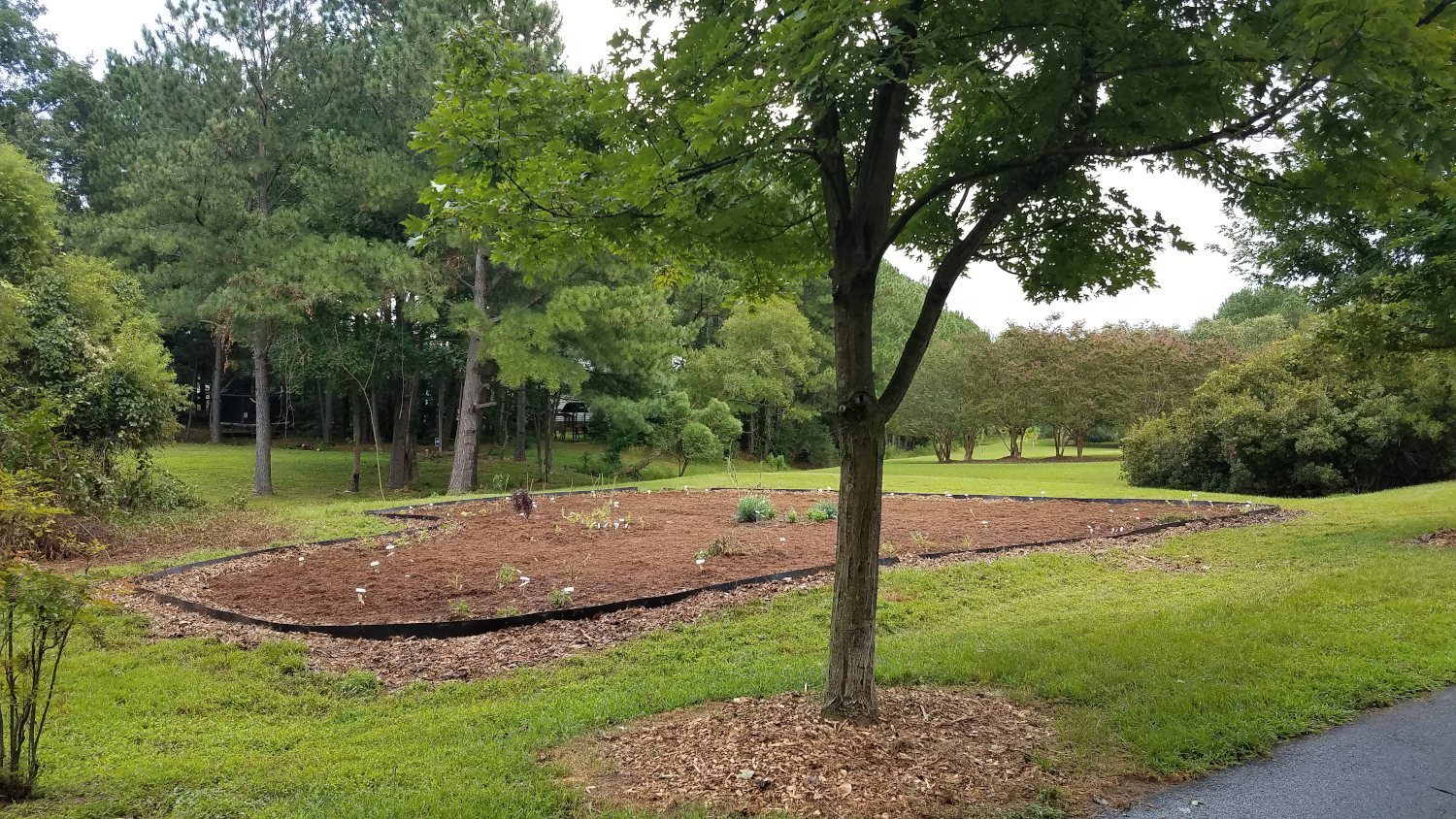

| HOME | PLANTINGS | ABOUT | THE PAST | THE FUTURE | ARCHIVE ACCESS |
| LONGLEAF PINE SAVANNA | POLLINATOR GARDEN | FOOD FOREST | ROCKERY I | ROCKERY II |
| VOLUNTEERS | BIRD SPOTTING | STREAM REPAIRS |
| OPTIMIST FARM TREE ARCHIVE – Day One |
— The garden earned the North Carolina Native Plant Society's prestigious B. W. Wells Stewardship Award. —
Plants for the Garden were sourced from:
 |
 |
 |
and from gardens of volunteers who brought cuttings from their own native pollinator plants.
The Cary Tree Archive dedicated roughly half an acre for a Pollinator Garden built under the direction of Dr. Richard Carroll. The gardenwork began in July, 2020, when about 3,000 square feet was covered by opaque plastic. For seven weeks the sun scorched the grass and weeds. In September, the dead and cooked grass and weeds were ground up and mixed with the soil, which was then amended with compost and mulched. On Sunday, September 27, 2020, these volunteers planted locally-sourced, native perennial flowers and bushes.
| Lydia Best | Mary Ann Borisow | Richard Carroll |
| Ethan Cassidy | T. J. Cawley | Kyra Chaput |
| Michael Collado | Brie Davidson | Lisa Englert |
| Alex Good | Shuchi Gupta | Kelawni Hansquine |
| Paige Hornsby | Matthew Hutzenbuhler | Rachael Jessup |
| Jiarui Li | George McDowell | Geraldine McDowell |
| Lois Nixon | Ryan Perry | Nathan Poupart |
| Taylor Short | Christy Spain | Logan Weber |
| Dick Wilson | Gina Wilson | Sarah Wozniak |

The power of volunteers working together.
Fall is the ideal time to plant because the plants concentrate on root growth and become established. By spring, these now well-adapted plants will thrive, bloom, and grow. The perennial flower garden is enhanced by native pollinator and bird-friendly trees and shrubs to fill out the area.
To restore an ecosystem as well as the gardens and agriculture that we depend on requires restoring native pollinators. A pollinator is an animal that carries pollen from the male anther of a flower to the female stigma of a flower. This helps to bring about fertilization of the ovules in the flower by the male gametes from the pollen grains. Birds, bats, bees, butterflies, beetles, and other small mammals that pollinate plants are responsible for bringing us one out of every three bites of food we consume. They also sustain our ecosystems and produce our natural resources by helping plants reproduce. Without the actions of pollinators, agricultural economies, our food supply, and surrounding landscapes would collapse. Habitat fragmentation, pesticide use on lawns and gardens, planting of exotic-plant species — characteristics of suburban neighborhoods — lead to a decline in native pollinators, birds, and wildlife.

The solid olive drab shows that part of the Archive's Pollinator Garden on which construction has begun. When the first phase of construction is completed and the plants are stable, the next phase will be started. Construction and planting plans are firm to the second week in October and soft thereafter. It may take us three years to complete the full scope of the Pollinator Garden.
Butterflies and caterpillars (the larval stage in the butterfly life cycle) provide food for birds and other organisms, pollinate flowers, and are easy to attract to a garden or backyard landscape. Butterflies are found throughout North Carolina and will flourish within a well-designed landscape of native plants. In the Pollinator Garden, we are planting a variety of both nectar plants for adults and host plants for caterpillars in a sunny location that will ensure many hours of viewing pleasure as butterflies visit the garden.

The Lillian Mae Carroll Garden
September 11, 2020
By promoting native plant species beneficial to hummingbirds and butterflies, we will ensure food and cover are available to attract these colorful critters.
North Carolina is home to more than 500 species of native bees, many of which are economically important pollinators. These insects are essential for agriculture, home gardens, and natural habitats in our state.
Bees pollinate food plants. In North Carolina alone, bee pollination accounts for about $120 million in commercial fruit and vegetable yields annually. Managed honeybees do much of this work, and native bees do the rest. Even when honeybees are present, native bees improve yields of many fruits, nuts, and vegetables. Home and community gardens also incorporate many bee-dependent crops such as tomatoes, blueberries, and pumpkins.
There are some downsides to raising honeybees, however. Honeybees are non-natives and succumb to parasites and disease. While we manage honeybees for honey and pollination, there is concern that honeybees are out-competing native bees in the wild. Large monoculture crops, which replace native habitats as well as native pollinators, have become more dependent on honeybees for pollination. While honeybees are a non-native species, native, wild, solitary bees are the super-pollinators of our native flowers and plants. If you are getting bees to pollinate your food (not to produce honey), consider a solitary bee house and encourage native plants and wildflowers!
Native bees pollinate wild plants. Most flowering plants (not just crops) benefit from animal pollinators, especially bees. Many of North Carolina’s native plants, from Claytonia to coneflowers, reproduce and maintain robust populations with the help of native bee pollinators.
Native bees are easy to support in your yard. Not everyone wants to manage a honeybee hive, but you can attract and support wild bees with minimal effort. You may even find that observing bees — their diversity of forms and behaviors — enriches your experience of your yard and garden.
The main threats facing native pollinators are habitat loss, degradation, and fragmentation. As native vegetation is replaced by roadways, manicured lawns, crops and non-native gardens, pollinators lose the food and nesting sites necessary for their survival.
Migratory pollinators face special challenges. If distances between the suitable habitat patches along their migration routes are too great, smaller or weaker individuals may die during their journey.
The improper use of pesticides can negatively impact pollinators and their habitats. Pesticides such as weed killers and insecticides which are designed to prevent, destroy, or repel insects, mice, and other animals, weeds, fungi, bacteria, and viruses can also kill beneficial pollinator insects. Pesticides are used in nearly every home, business, farm, school, hospital, and park in the United States and are found almost everywhere in our environment.
While we devote a large area of the Archive to wildlife gardening, just a small patch in your own yard can provide essential caterpillar host plants and nectar sources to attract butterflies, native bees, and hummingbirds.
The Pollinator Garden will aid pollinators to support the restoration of a native-forest ecosystem in the Cary Tree Archive. The perennial, native species of plants that have been selected will provide nectar, food, beauty, and blooms throughout the season. Please come by and become inspired to grow your own pollinator garden at home! Volunteers are welcome to plant and maintain specific plants at the Cary Tree Archive.
This garden – these flowers in the sun – are dedicated to my mother, Lillian Mae Wolcott Carroll,
who made the love of nature a fundamental part of my life.
My mother was known as Lill the Flower Lady. She was the naturalist in residence and I was Mother Nature’s son. She ran the nature center at Camp Laurel Hill, the Girl Scout camp in our little town of Cheshire, Connecticut. Anyone who found a turtle or snake would bring it to her to identify. She taught principles of conservation biology to the scouts and to my sister and me. Her ‘conservation list’ cataloged those native plants and animals that were rare or had a key role in the ecosystem and should not be disturbed. She taught conservation biology before conservation biology was cool. This was the foundation that would support me throughout my career and in every aspect of my life.
Cheshire was a farm town then, and my parents' turkey farm had as many as ten thousand free-ranging turkeys in the back lot. It was intimidating to stand eye-to-wattle with those turkeys! On the farm and in the woods, we learned ‘common sense,’ not hard and fast rules. She taught us not only to know nature on a first-hand basis, but to feel the flow of life deeply.
At that time, I could walk the 20+ miles from Cheshire to New Haven without crossing a road. Now, as in Cary, those New England farms grow houses. A paradigm shift has taken place, and most current residents are completely unaware of what these towns once were.
The Cary Tree Archive is an ecosystem-restoration program. It is a reminder of what was and still can be. That paradigm shift can shift back. It is a vision for a rebirth, a place where we can feel the flow of life again, as my mother taught us. Join us to rebuild this vision, plant native trees, rebuild the soil, and feel the shade.
The pollinator garden is a small part of this ecosystem and contains many of the native plants on my mother’s conservation list. These are the plants that attract native bees, butterflies, and other native species that pollinate the crops that become our food as well as the trees in the Archive. This is the paradigm shift on which our lives depend.